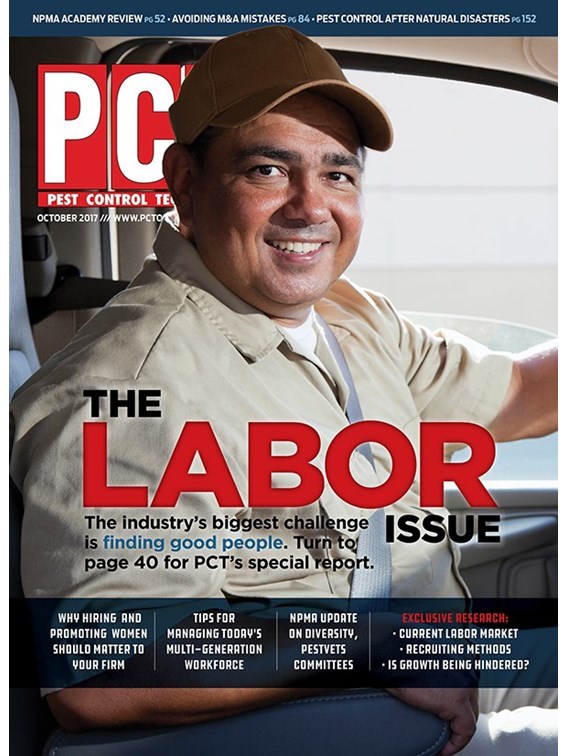
Cole Porter had it all wrong. If you’re taking a trip to the moon, gossamer wings are only going to slow you down. Jetting to Paris or Pittsburgh? Same problem.
The wild blue yonder may look pretty empty, but as pest management professionals know, it isn’t. Most of what’s happening up in the sky never shows up on an air traffic controller’s radar screen. There’s more to the sky than meets the eye, and a lot of it is...bugs.
You wouldn’t think a dragonfly or a wasp could be a concern for aircraft, much less gnats and mosquitoes. Wrong again! Insects have been causing problems for airplanes ever since humans began to fly the friendly skies. One bug doesn’t make a measurable difference; however, the accumulation of hundreds or thousands of bug parts on wing edges makes engines work harder.
We’re oblivious to it as we stroll down the street but moving through air, even bug-free air, creates friction; the larger and faster the object, the greater the resistance (a.k.a., drag). Engineers design aircraft wings to encourage laminar flow — smooth movement of air over a surface — reducing the amount of energy it takes to fly. Fuel is a major expense for airlines; the U.S. Department of Transportation estimates improving the flow of air over wings could save the industry more than $2 billion annually.
To get the maximum benefit out of any aerodynamic design, though, the surface needs to be clean, and stay clean. That’s no small feat.
BUG-FREE SKIES? In an interview with the TravelSkills blog, United Airlines’ Jennifer Dohm explained that it takes about five hours for a crew of three to five people to wash a wide-body aircraft. It’s all done by hand and United gives every plane in its fleet a bath every four to eight weeks. The schedule takes into consideration not only how long it’s been since the last cleaning but when an aircraft will have a layover of at least eight hours at one the 14 commercial airports around the world where United has washing facilities. According to Airfleets.net, United has at least 730 aircraft currently in services. Keeping all of those planes spick-and-span is a physical and logistical chore that could cause even June Cleaver to throw in the towel.
As anyone who has tried to clean their windshield with a gas station squeegee knows, it takes some serious persistence and elbow grease to remove bug remains, even from a smooth-as-glass surface. But have you ever wondered why? Researchers at NASA and Boeing did. They discovered when an insect impacts a hard object moving at high velocity the bug body ruptures and fluids inside undergo a chemical transformation, becoming more viscous and tacky.
Scientists with the Environmentally Responsible Aviation (ERA) Project reasoned that the best way to keep an airplane wing clean would be to prevent anything from sticking to it in the first place…including insects and their diaphanous flight appendages. The “bug team” has developed hundreds of non-stick coatings and performed initial experiments in small wind tunnels. The top performers were then applied to aircraft wings and tested by pilots doing multiple takeoffs and landings, as well as flying at low altitudes in and around Shreveport, La., a place many, many, many insects call home.

Some coatings decreased the amount of residue. Others reduced residue area and height (yes, the height of residue is a major concern here). But there’s more to this research than counting and measuring bug splats. The coatings also have to be durable enough to last for several years, even when experiencing repeated exposure to extremes of temperature, various forms of precipitation (rain, sleet, snow, ice), ultraviolet radiation and nose-to-tail scrubbings every month or two. Moreover, the fuel-saving benefits have to add up to more than the cost of the coatings.
Recently, researchers have discovered that nature may offer a better non-stick solution than Teflon. Mia Siochi, senior materials scientist at NASA Langley Research Center in Hampton, Va., explained that the coating inspired by a lotus leaf was the clear winner. Although lotus leaves appear smooth to the naked eye they’re actually covered in tiny ridges, causing surface tension that makes liquids bead up and roll off rather than adhere. The team used that principle, in combination with chemistry, to create a surface that allows planes to shrug off bug guts as easily as lotus leaves shake off raindrops. Siochi reports the improvement was clearly visible once the test plane was back on the ground.
Let me get this straight — making the surface microscopically rough is the way to smooth the flow of air over a wing?
I guess it’s just one of those things.
Dr. Kieran Lindsey loves looking for wild things in all the wrong places…so she became an urban wildlife biologist. She also has way too much fun as the official Animal-Vehicle Biologist for NPR’s “Car Talk.” Read her blog at www.nextdoornature.org.

Explore the October 2017 Issue
Check out more from this issue and find you next story to read.
Latest from Pest Control Technology
- Orkin Helps Local Youth Sports Program Design a ‘Killah’ New Logo
- ABC Home & Commercial Services Celebrates 75 Years in Business
- NPMA Academy Announces Full Schedule
- Truly Nolen Promotes Marchello, Christopherson and Bolton to Managerial Positions
- TruGreen Announces 2024 List of Top 20 U.S. Buggiest Cities
- Why PMPs Use Rodent Bait Stations
- NPMA’s Women’s Forum Encouraged Female Leadership, Growth Opportunities in Pest Control
- GoPest Expands to Birmingham and Huntsville (Ala.)





